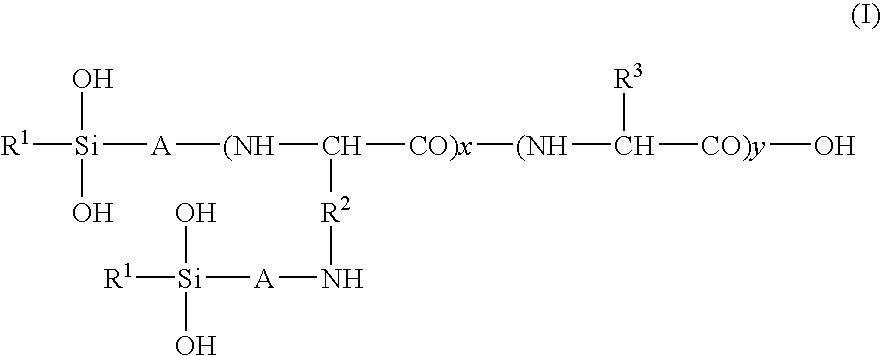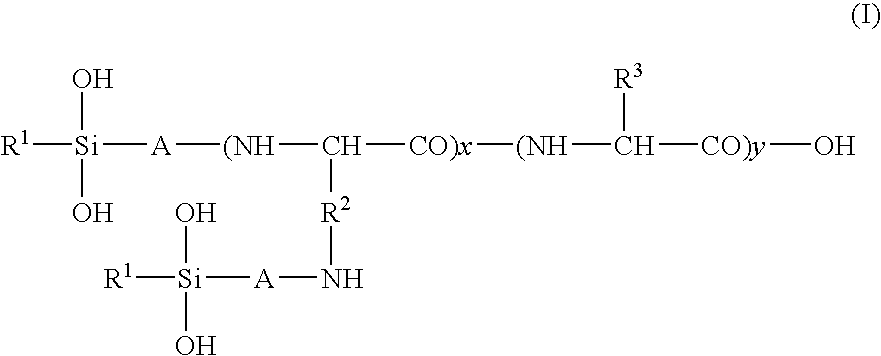Hair treatment agent, shampoo and hair coloring agent
a hair treatment agent and shampoo technology, applied in the field of hair treatment agents, shampoo and hair coloring agents, can solve the problems of deteriorating hair springness, prone to stickiness, silicone and oily materials cannot exert enough properties on damaged hairs, etc., to prevent split hair formation, improve combability, and good gloss and spring to hairs
- Summary
- Abstract
- Description
- Claims
- Application Information
AI Technical Summary
Benefits of technology
Problems solved by technology
Method used
Image
Examples
production example 1
Production of N-[2-hydroxy-3-(3'-methyldihydroxysilyl)propoxy]propyl hydrolyzed sericin-dimethyldiethoxysilane-octyltriethoxysilane copolymer composition [1:25:25 (Molar Ratio)]
[0103] Into the reaction vessel made of glass shaped in cylinder with round bottom of Its Inner diameter of 12 cm and its volume of 2 liters, 200 g of 10% aqueous solution of N-(2-hydroxy-3-(3'-methyldihydroxysilyl)-propoxy]propyl hydrolyzed sericin (,wherein the number average molecular weight of said hydrolyzed sericin is about 500) and 11.5 g of 18% aqueous solution of hydrochloric acid were added to adjust pH of a mixture to 1.5 and said mixture was heated up to 60.degree. C., While the mixture being stirred in 400 rpm, the mixture of 99.1 g of dimethyldiethoxysilane (a trade name of KBE-22, manufactured by Shin-Etsu Silicone Co., Ltd.) and 184.7 g of octyltriethoxysilane (a trade name of A-137, Nippon Unicar Co., Ltd.) was dropped into said mixture for 5 hours, and then, after said dropping being complet...
production example 2
Production of N-[2-hydroxy-3-(3'-methyldihydroxysilyl)propoxy]propyl hydrolyzed collagen-dimethyldiethoxysilane-octyltriethoxysilane copolymer composition [1:25:25 (Molar Ratio))
[0106] Into the reaction vessel made of glass shaped in cylinder with round bottom of its inner diameter of 12 cm and its volume of 2 liters, 150 g of 10% aqueous solution of N-[2-hydroxy-3-(3'-methyldihydroxysilyl)-propoxy]propyl hydrolyzed collagen (, wherein the number average molecular weight of hydrolyzed collagen is about 500) and 7.6 g of 18% aqueous solution of hydrochloric acid were added to adjust pH of the mixture to 1.5 and said mixture was heated up to 60.degree. C. While the mixture being stirred in 400 rpm, the mixture of 79.7 g of dimethyldiethoxysilane (a trade name of KBE-22, manufactured by Shin-Etsu Silicone Co., Ltd.) and 148.6 g of octyltriethoxysilane (a trade name of A-137, Nippon Unicar Co., Ltd.) was dropped into said mixture for 5 hours, and then, after said dropping being complete...
production example 3
Production of N-[2-hydroxy-3-(3'-methyldihydroxysilyl)propoxy]propyl hydrolyzed silk-dimethyldiethoxysilane-octyltriethoxysilane copolymer composition [1:40:40 (Molar Ratio)]
[0109] Into the reaction vessel made of glass shaped in cylinder with round bottom of its inner diameter of 12 cm and its volume of 2 liters, 127.3 g of 10% aqueous solution of N-[2-hydroxy-3-(3'-methyldihydroxysily-l)propoxy]propyl hydrolyzed silk (, wherein the number average molecular weight of hydrolyzed silk is about 600) and 4.8 g of 18% aqueous solution of hydrochloric acid were added to adjust pH of the mixture to 1.5 and said mixture was heated up to 60.degree. C. While the mixture being stirred in 400 rpm, the mixture of 88.0 g of dimethyldiethoxysilane (a trade name of KBE-22, manufactured by Shin-Etsu Silicon Co., Ltd.) and 164.0 g of octyltriethoxysilane (a trade name of A-137, Nippon Unicar Co., Ltd.) was dropped into said mixture for 5 and half hours, and then, after said dropping being completed,...
PUM
| Property | Measurement | Unit |
|---|---|---|
| viscosity | aaaaa | aaaaa |
| weight % | aaaaa | aaaaa |
| pH | aaaaa | aaaaa |
Abstract
Description
Claims
Application Information
 Login to View More
Login to View More - R&D
- Intellectual Property
- Life Sciences
- Materials
- Tech Scout
- Unparalleled Data Quality
- Higher Quality Content
- 60% Fewer Hallucinations
Browse by: Latest US Patents, China's latest patents, Technical Efficacy Thesaurus, Application Domain, Technology Topic, Popular Technical Reports.
© 2025 PatSnap. All rights reserved.Legal|Privacy policy|Modern Slavery Act Transparency Statement|Sitemap|About US| Contact US: help@patsnap.com



